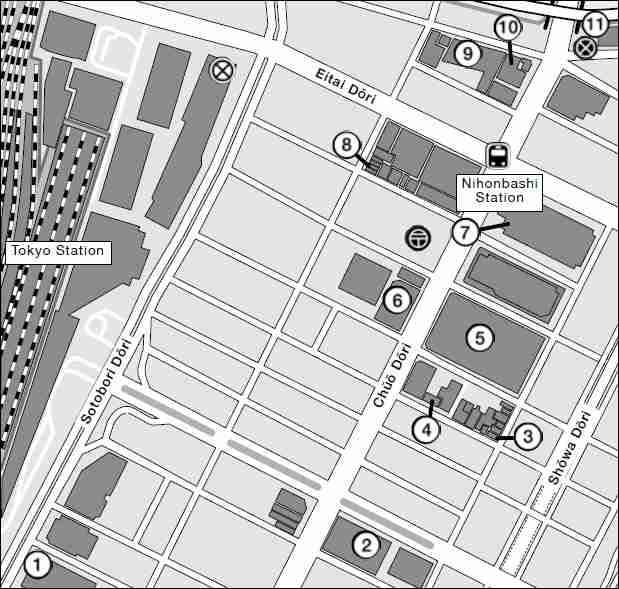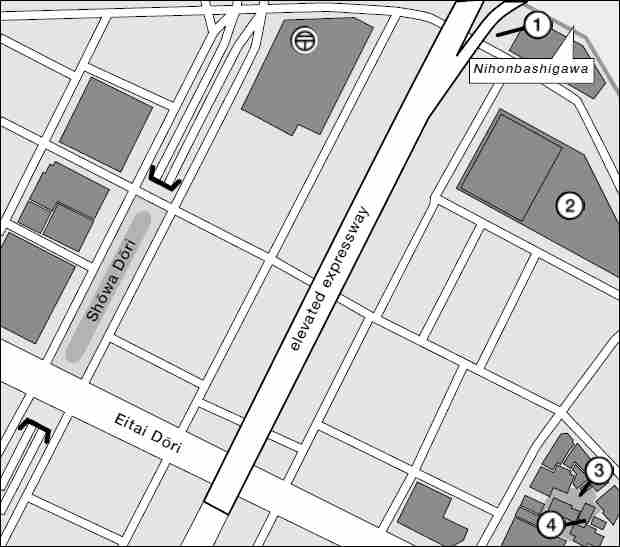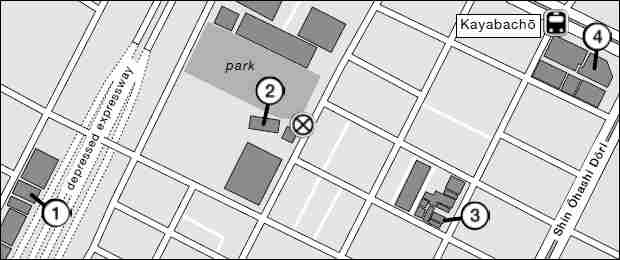日本橋地区 南部 • 京橋 • 八重洲
NIHONBASHI SOUTH, KYŌBASHI, AND YAESU
The area south of the Nihonbashigawa is often spoken of as if it is part of the Ginza; to be precise, it is just north of the Ginza. Like the other side of the river and the Ginza, it has many high-end shops, older businesses, museums, and shrines, plus a significant financial institution, the Tokyo stock exchange.
DETAIL 1
Designed by Kajima Design and built in 1978 to house the main store of what would become a bookshop chain, the building is influenced by early modernist buildings in Europe. All told there are nine stories to the bookshop if you count the basement. The seventh floor holds the section for non-Japanese language books and magazines: English, French, and Italian are all represented here. Before the store was built, the location was that of the headquarters of Kajima Corporation, a construction company that decided to establish a bookshop. Kajima Morinosuke came up with the idea for the store when he realized that many scholarly books were not easily available in bookshops. His solution was to build the largest bookstore in Japan.
NIHONBASHI SOUTH, KYŌBASHI, AND YAESU
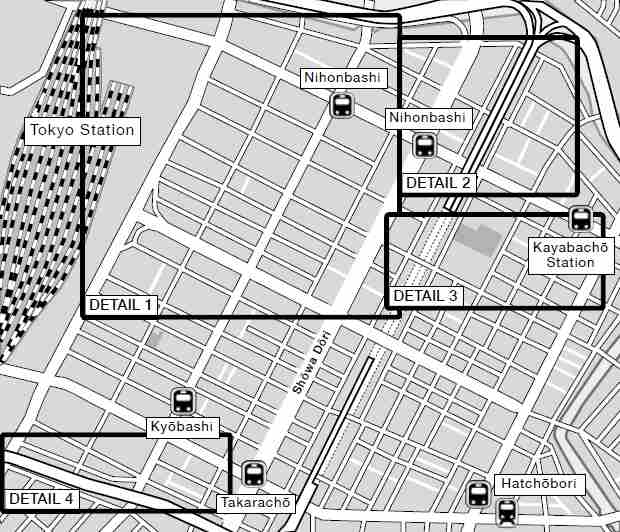
NIHONBASHI SOUTH DETAIL 1
 Artizon Museum / Ātizon Bijutsukan アーティゾン美術館
Artizon Museum / Ātizon Bijutsukan アーティゾン美術館
This is a major collection of art in the Bridgestone building. The core collection is mainly by Western and Japanese artists who work in a Western style. Art from earlier periods is also part of the collection. The museum was founded in 1952 as the Bridgestone Museum of Art. The early collection was composed of items owned by Ishibashi Shōjirō, founder of Bridgestone. Over time the space devoted to the museum in the building grew, as did the collection. In 2015 the museum temporarily closed, the nine-story building was demolished, and a new twenty-three-story building built. The museum re-opened in early 2020 under the new name, which was created by combining the words Art and Horizon to signify its rebirth.
One of the more famous sushi restaurants in Tokyo, founded in 1879. In 1918 they introduced toro nigirizushi to their customers, and from there it spread throughout Japan. The third owner also has penned several books on sushi. The sushi served are large, an old style of Edo sushi. Lunch is reasonably priced; dinner will set you back more.
This basement shop sells atlases, maps, topographic maps, globes of all kinds, reproductions of old Japanese maps, even maps of the course of major rivers, as well as map-themed items such as tote bags and coffee mugs. Most of the stock is in Japanese, however they have many unique items such as volumes from the large series of specialized reference atlases put out by Zenrin. The store was opened in 2007 as a subsidiary of the map publisher Buyodō, which was founded in 1897. Buyodō started publishing books early in their history; it was not long before they also started releasing maps, eventually making that the major part of the business after World War II.
The first Tokyo store of this chain, founded in Kyoto in 1831, opened here in 1933. This building was the first department store to be registered as an Important Cultural Property by the Japanese government. Even if you are not interested in shopping, the store, with its mix of Japanese and Western design, is a delight to the eyes and worth a stroll inside. If you count the two basement levels and the open rooftop, there are eleven stories to enjoy. There is also a six-story annex. The elevators still have operators who have a set routine to ensure the best possible service—take the elevator to experience this up close. The rooftop includes a large garden with seating areas. If you are ready for lunch you can explore the basement levels, pick up some food to go, and then take the elevator up to the rooftop to sit, relax, and eat outdoors. From 1950 to 1954, the rooftop was also the home of a popular baby elephant named Takako before she moved to the Ueno Zoo.
 https://www.takashimaya.co.jp/nihombashi/index.html
https://www.takashimaya.co.jp/nihombashi/index.html
The Nihonbashi branch of the famous bookstore. While the selection is not as large as in the nearby Marunouchi store, it is still extensive. There is an English language section devoted to books, both fiction and non-fiction, related to Japan. One bit of history to note is that this was the original Tokyo location for Maruzen.
A shop devoted to traditional paper and products made from it, in business since 1806. The main papers here are washi, gambi, and chiyogami. While washi is made from a variety of plants, gambi paper uses the gambi plant and has a different smooth and glossy texture. Chiyogami is paper with repeating patterns printed on it. The shop stocks a sizeable variety of each, brought in from all over Japan. Besides selling the paper itself, there are boxes, fans, envelopes, and letter paper. The store facade is a pleasant gray with a motif of repeating diamonds, some of which are windows allowing light to shine out.
 http://www.haibara.co.jp/en/
http://www.haibara.co.jp/en/
 http://www.norenkai.net/en/portfolio-item/haibara/
http://www.norenkai.net/en/portfolio-item/haibara/
The present three-story building dates from 1960 and is in the original 1902 location. The menu includes a large variety of dishes, with a unique curry called Nanban as their signature dish. It comes with your choice of noodles. Seating is mainly Western style, with traditional seating on the third floor.
This shop is especially known for its traditional Japanese sweets. Founded in 1857, it was originally a concession in the Nihonbashi fish market. Today the main store and a tea room are in the Eitarō Building. They produce a large variety of products, some that should be consumed with a couple of days of purchase, others that are dry and will easily last a trip home. They also have a branch in Takashimaya, the Nihonbashi Mitsukoshi, and numerous other locations in Tokyo.
 http://www.norenkai.net/en/portfolio-item/eitaro-confectionery-co-ltd/
http://www.norenkai.net/en/portfolio-item/eitaro-confectionery-co-ltd/
Japanese lacquer is wonderful stuff. You can paint it on anything, it is water resistant, flexible, and long lasting, and it can be processed to be in several different colors. This long-established shop, in business since 1689, has many examples, ranging from traditional items like serving bowls, trays, cups, and chopsticks to modern products including clocks, mouse pads, LCD magnifying glasses, picture frames, jewelry, and more.
The store is housed on the second floor of the Kuroeya Kokubu Building, which appears to be just an office building at first glance, and so the store is not obvious from the street.
 http://www.norenkai.net/en/portfolio-item/kuroeya/
http://www.norenkai.net/en/portfolio-item/kuroeya/
NIHONBASHI SOUTH DETAIL 2
 Nihonbashi Tourist Pier / Nihonbashi Kankō Sanbashi 日本橋観光桟橋
Nihonbashi Tourist Pier / Nihonbashi Kankō Sanbashi 日本橋観光桟橋
Located just east of the Nihonbashi is a pier from which several cruise and tour companies depart. These currently are the Limousine Boat, which is an enclosed and fast but not cheap form of transportation that also goes to Haneda Airport; Edoventure Cruise for private parties; and (my favorite) Riverboat Mizuha, which does both private charter and scheduled tours with a guide who also speaks English.
Limousine Boat:
 https://www.limousineboat.com
https://www.limousineboat.com
Edoventure Cruise:
 http://www.edoventure-cruise.com
http://www.edoventure-cruise.com
Riverboat Mizuha:
 https://www.funaasobi-mizuha.jp/english/
https://www.funaasobi-mizuha.jp/english/
DETAIL 2
Built in 1878 next to the old stock exchange, the shrine remained when the exchange moved to a nearby location. Uka no Mitama no Mikoto, who is associated with agriculture, is the kami enshrined here. Since many securities firms and the Tokyo Stock Exchange are nearby, it is no surprise that many who come here to pray are involved in finance. The shrine is maintained by employees of the stock exchange.
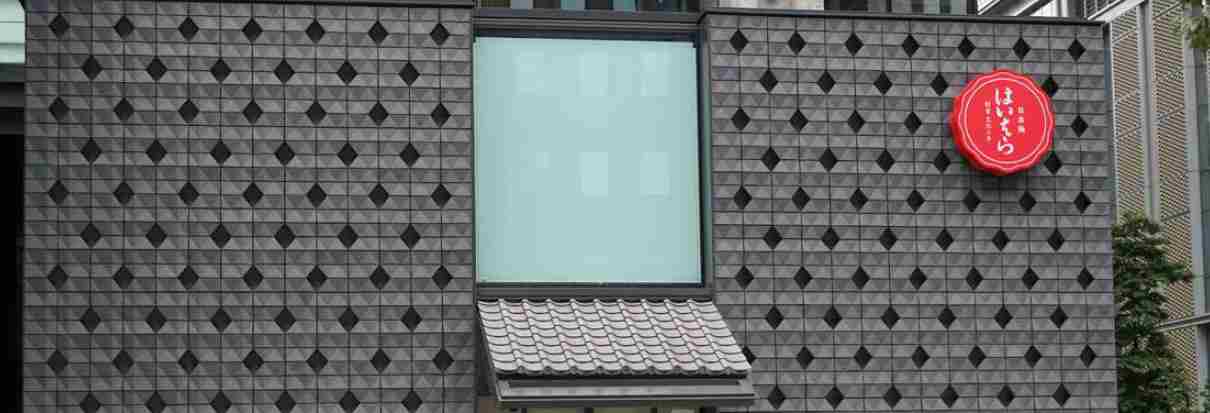
▲ The traditional paper goods shop Haibara, with its distinctive facade, is hard to miss.
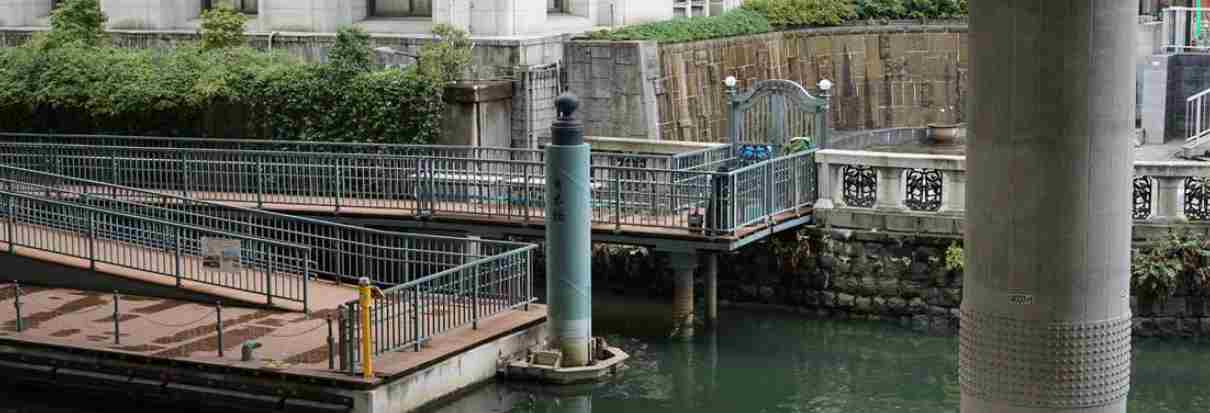
▲ Along the old stonework is the Nihonbashi Tourist Pier from which tour boats depart.
 Tokyo Stock Exchange / Tōkyō Shōken Torihikijo 東京証券取引所
Tokyo Stock Exchange / Tōkyō Shōken Torihikijo 東京証券取引所
The first stock exchange in Japan was established nearby in 1878 but closed during World War II. The present institution dates from 1949. The present building dates from 1985. The building is open to visitors during trading hours after signing in at the reception desk at a separate entrance.
Established in the early Edo period, this shrine is hidden away from the bustle of the street, as it is surrounded by buildings and nestled in a tree-filled lot. The famous writer Junichirō Tanizaki lived near here and wrote about how amateur theater troupes would use the kagura stage for performances.
 Hie Jinja Nihonbashi Sessha 日枝神社日本橋摂社
Hie Jinja Nihonbashi Sessha 日枝神社日本橋摂社
This shrine is away from the busy nearby streets and is surrounded by trees, providing a peaceful spot in the neighborhood. This Hie shrine is a subsidiary of the Akasaka Hie Jinja that is covered in the Marunouchi to Nagatachō chapter. During the Sannō Matsuri, held every two years in June, the procession of mikoshi enters these grounds, a ritual is performed, and then they continue on their way.
DETAIL 3
A soba restaurant that first opened in 1882. While the building is modern, the entrance has a traditional feel to it with a tile roof on the gate, old-style walls, and vegetation. The restaurant has three floors with both traditional and Western seating. They also occasionally schedule rakugo performances on the third floor for a reasonable fee.
 http://www.yabuizu-souhonten.com
http://www.yabuizu-souhonten.com
 Kabutochō Kayabachō Machikado Museum / Kabutochō Kayabachō Machi Kado Tenjikan 兜町・茅場町まちかど展示館
Kabutochō Kayabachō Machikado Museum / Kabutochō Kayabachō Machi Kado Tenjikan 兜町・茅場町まちかど展示館
Located in a park, this is a display of local mikoshi, leather haori that local fire brigades would use, photographs, lanterns, and various other items. These are housed in a building with one side consisting of three large windows, so the items are easily visible.
 http://chuoku-machikadotenjikan.jp/tenjikan/kabutocho_kayabacho/
http://chuoku-machikadotenjikan.jp/tenjikan/kabutocho_kayabacho/
NIHONBASHI SOUTH DETAIL 3
Established in 1897, this restaurant specializes in chicken and eel. Their yakitori and sukiyaki are both popular. All ingredients are delivered fresh every day. The seating is both traditional and Western with the traditional seating in rooms that can have partitions removed to combine them for larger groups.
Established in 1907, this restaurant specializes in soba made from freshly ground buckwheat as well as tempura made from fresh seasonal vegetables and seafood. The noodles are handmade daily. Besides soba, they have a variety of seafood and reasonably priced set meals.
DETAIL 4
A long-established liquor store, founded in 1892 and headquartered in Yokohama. They established the Ginza store in 2008 by moving their Marunouchi store to the present location under the expressway. The store has a very large selection of nihonshu (what Westerners commonly call sake), shōchū, wine, and other alcoholic beverages.
This small wooden Inari shrine is nestled in the kind of side street that abuts backside of buildings. Once you find the street one block north of the expressway, the shrine is easy to locate, as the bright red torii and fence stands out surrounded by black, gray, and silver structures. This shrine is raised several feet off the street level and has a set of stairs with enough room for one person to get close to it.
 Police Museum / Keisatsu Hakubutsukan 警察博物館
Police Museum / Keisatsu Hakubutsukan 警察博物館
Few cities have a police museum, however Tokyo is a city with many small specialized museums. You can spot the building by the large statue of Pipo-kun, the mascot of the Metropolitan Police Department, and a motorcycle on display out front. Those interested in the history of Tokyo’s police since the Meiji period will find plenty of interest. There are exhibits on investigative techniques, police equipment, and traffic safety simulation games. Some exhibits have English labeling. Photographs are only allowed on certain floors. Kids can even dress up in uniforms for those photos parents love to take.
 https://www.keishicho.metro.tokyo.jp/multilingual/english/about_us/Police_Museum.html
https://www.keishicho.metro.tokyo.jp/multilingual/english/about_us/Police_Museum.html
 National Film Archive of Japan / Kokuritsu Eiga Ākaibu 国立映画アーカイブ
National Film Archive of Japan / Kokuritsu Eiga Ākaibu 国立映画アーカイブ
Originally, in 1952, this was the film library of The National Museum of Modern Art. The museum opened in 1970 as the National Film Center in this location. The present building dates from 1995. In April 2018, the National Film Archive of Japan became an independent entity. The museum houses two cinemas, an exhibit hall, and a library, which are open to the public. The archive collects documents and film prints related to Japanese cinema. They currently have over 80,000 films in their collection, as well as an extensive collection of documents, books, posters, equipment, photos, and more. They are famous for their restoration work on various movies over the years. As film is perishable, reels are stored off-site in temperature- and humidity-controlled facilities.
 http://www.nfaj.go.jp/english/
http://www.nfaj.go.jp/english/
This shop sells just brooms, cleaning brushes, and some accessories to use with them. But what wonderfully made brooms—all crafted by hand from natural materials, all in designs that have existed since the Edo period when the shop first opened in 1830. Originally this shop made tatami mats; however, you need good brooms for cleaning mats, and later the shop changed their product. If you have any appreciation for fine handcrafted everyday tools that are reasonably priced, this is a shop for you. Even if you don’t plan to buy anything, the stock is a delight to view, and who knows, you may find a gift for someone or something for yourself.
 http://www.norenkai.net/en/portfolio-item/shirakiya-denbei/
http://www.norenkai.net/en/portfolio-item/shirakiya-denbei/
NIHONBASHI SOUTH DETAIL 4

